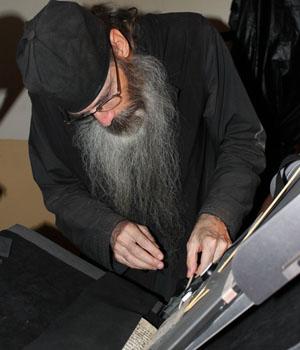Monks, scientists partner to reveal hidden messages beneath centuries-old texts
Father Justin, the Saint Catherine’s Monastery librarian, affixes one page of a manuscript to the spectral imaging machine. (Photo by Noel King.)
Monks have lived for at least 17 centuries at Saint Catherine’s Monastery.
It sits on a mountaintop — in the southern part of the Sinai Peninsula, a triangular peninsula that sits between the Mediterranean and the Red Sea.
Evidence of the monastery’s age is everywhere. Grooves are worn into Saint Catherine’s stone staircases – the legacy of a thousand years of footfalls.
Knights from the crusades carved graffiti into the stone walls. A shrub in the courtyard is believed to be the burning bush of Biblical lore.
See more pictures from the monastery at TheWorld.org.
“In ancient times, Sinai was the most remote of all the Christian pilgrim sites,” says Father Justin, the monastery’s librarian. “And the monks who came here were coming to the edge of the inhabitable world. It was such a harsh desert, people came here for the silence and because this had been the place sanctified by the revelations of God.”
That history has led Saint Catherine’s to a remarkable partnership between monks and scientists. They’re all trying to recover some hidden writings that date back more than a millennium.
Father Justin oversees a treasure trove of ancient texts. Because the monastery is so remote, and because the dry, mountain air is so conducive to preservation, the library at St. Catherine’s holds manuscripts that date as far back as the fifth century.
For many years, monks and scholars have known that some of the manuscripts are special. They are old, yes, but there is even older writing hidden underneath their pages. These manuscripts are called palimpsests, said Mike Phelps director of the Sinai Palimpsests Project.
“Writing material was extremely expensive in the ancient and medieval worlds, so a medieval scribe would scrape or wash a pre-existent manuscript to make them reusable for a new manuscript,” Phelps said. “They were never able, or almost never able, to perfectly erase the underlying layer. It appears as sort of a coffee-brown stain on the manuscript. You can see that the writing is there, but it is not necessarily legible.”
Phelps and a team of scientists and engineers — specialists in physics, optics and lens design — are attempting to read the ancient texts using high-tech imaging tools. In a darkened command center beside the monastery’s library, each page of a manuscript is photographed 31 times in a range of light wavelengths.
Once the page has been digitized electronically, computer programs combine all of the spectral data and, almost like invisible ink, the writing underneath emerges.
Thirty one pictures, all of the same page. And nobody has seen the writing underneath this page for about a thousand years.
The first word that shows up is Pateron.
This turns out to be a letter of advice from an elder monk, a pateron, to a novice. Who was this monk? Why did he have access to valuable parchment? Was he someone important?
Once scholars can see more of the hidden writing, they’ll try to answer those questions. And while they aren’t sure what they’ll find, other manuscripts at Saint Catherine’s have yielded treasures in the past — including two literary texts in a lost language called Caucasian Albanian, used by an ancient Christian kingdom in western Azerbaijan, destroyed in the 7th or 8th century.
The simple, deliberate lifestyle at the monastery seems contrary to the high-tech science taking place. The monks wear traditional black robes, and gather to pray several times a day. They converse mostly in Greek.
The monastery’s abbot, 76-year-old Archbishop Damianos, says it doesn’t bother him that the scientists mostly want to see their cutting-edge equipment work wonders — while the monks want to see what the hidden texts might reveal about God’s wonders. He says he’s thought a lot about it and he believes scientific and theological objectives don’t have to conflict.
“Theology is not something you can come in direct contact with,” he said. “It is not material. In science, you can take a microscope and analyze things. Science is trying to find something material. Theology is trying to find the way that the soul can come closer to God. But both of them are about searching for something.”
The project is being paid for over the next four years by a British charity called Arcadia Fund — so the scientists and monks will have a good amount of time to debate how science and theology can get co-exist.
